Provenance and drainage system of the Early Cretaceous volcanic detritus in the Himalaya as constrained by detrital zircon geochronology
Xiu-Mian Hu , Eduardo Garzanti, Wei An
1. State Key Laboratory of Mineral Deposits Research, School of Earth Sciences and Engineering, Nanjing University, Nanjing 210029, China
2. Department of Earth and Environmental Sciences, Università di Milano-Bicocca, Milano 20126, Italy
Abstract The age range of the major intra-plate volcanic event that affected the northern Indian margin in the Early Cretaceous is here defined precisely by detrital zircon geochronology. U-Pb ages of Early Cretaceous detrital zircons found in the Cretaceous to the Paleocene sandstones cluster mainly between 142 Ma and 123 Ma in the northern Tethys Himalayan unit,and between 140 Ma and 116 Ma in the southern Tethys Himalayan unit. The youngest and oldest detrital zircons within this group indicate that volcanism in the source areas started in the latest Jurassic and ended by the early Albian. Stratigraphic data indicate that volcaniclastic sedimentation began significantly earlier in southern Tibet (Tithonian) than in Nepal (Valanginian), and considerably later in Spiti and Zanskar (Aptian/Albian) to the west. This apparent westward migration of magmatism was explained with progressive westward propagation of extensional/transtensional tectonic activity and development of fractures cutting deeply across the Indian continental margin crust. However, detrital zircon geochronology provides no indication of heterochroneity in magmatic activity in the source areas from east to west, and thus lends little support to such a scenario. Westward migration of volcaniclastic sedimentation may thus reflect instead the westward progradation of major drainage systems supplying volcanic detritus sourced from the same volcanic centers in the east. Development of multiple radial drainage away from the domal surface uplift associated with magmatic upwelling, as observed for most large igneous provinces around the world, may also explain why U-Pb ages of detrital zircons tend to cluster around 133-132 Ma (the age of the Comei igneous province)in Tethys Himalayan units, but around 118-117 Ma (the age of the Rajmahal igneous province)in Lesser Himalayan units.
Key words northern Indian margin, Cretaceous Himalayan Orogen, volcaniclastic detritus, drainage system, zircon geochronology, palaeogeography
1 Introduction*
In the Early Cretaceous, a major intra-plate volcanic event affected the entire northern India passive margin facing Neotethys, as long documented by studies of volcanic and volcaniclastic rocks exposed in various regions of the Himalayan orogeny (Figure 1). Lower Cretaceous volcaniclastic sandstones have been deposited all along the Tethys Himalayan domain, from the Zanskar Range(Baudet al., 1984; Garzanti, 1991, 1993a) to Spiti, Ne?pal (Bordetet al., 1971; Garzanti and Pagni Frette, 1991;Giblinget al., 1994; Garzanti, 1999) and southern Tibet(Jadoulet al., 1998; Huet al., 2008, 2010; Figure 2). Geo?chemical analyses of basaltic grains and detrital Cr?spinels from these sandstones point to the alkaline character of the volcanism, consistent with a “within?plate” tectonic set?ting (Dürr and Gibling, 1994; Zhuet al., 2004; Huet al.,2010, 2014). Lower Cretaceous volcanic rocks have never been reported so far in the western Himalaya, but are well known to occur in the Lesser Himalaya of Nepal (Aulis Trachyte; Sakai, 1983; Sakaiet al., 1992) and in the Tethys Himalaya of southeastern Tibet (Sangxiu Formation; Zhuet al., 2009; Qiuet al., 2010; Xiaet al., 2014). Mafic pro?toliths of late Early Cretaceous age have been recognized even in Lesser Himalayan eclogites of Nepal (Groppoet al., 2007). All of these volcanic rocks are generally con?sidered as belonging to the Rajmahal-Sylhet flood-basalt igneous province of the northeastern Indian subcontinent(Baksi, 1995; Kentet al., 2002) and/or to the Comei large igneous province (Zhuet al., 2009).
This article provides new U-Pb ages of zircon grainsfrom Lower Cretaceous volcaniclastic sandstones of the northern Tethyan Himalaya in southern Tibet, and a com?pilation of the available geochronological and isotopic data on detrital zircons from Cretaceous-Paleocene sand?stones of the northern Indian margin, including the Lesser and Tethys Himalaya. Based on the abundant and precise radiometric ages available for detrital zircons ultimately produced during the Early Cretaceous magmatic event,the age range of volcanic activity can be accurately con?strained. We also discuss the palaeogeographic signifi?cance of the Early Cretaceous volcanism, and the differ?ences observed in the age distribution of detrital zircons in different regions and tectonic domains of the Himalayan belt. The standardized time scale and web of correlation between relative biostratigraphic and absolute radiometric ages is after Ogget al.(2012).

Figure 1 a-Geological map of the Himalayan belt; b-Simplified geological map of the southeastern Tibet. Locations of sandstone samples considered for detrital?zircon geochronology are shown. GCT = Great Counter Thrust; ZGT = Zhongba-Gyangze Thrust;GKT = Gyirong-Kangmar Thrust; STDZ = South Tibetan Detachment Zone; MCT = Main Central Thrust; MBT = Main Boundary Thrust; MFT = Main Frontal Thrust; NTH = Northern Tethyan Himalaya; STH = Southern Tethyan Himalaya; GH = Greater Himalaya;LH = Lesser Himalaya.
2 Geological setting
During the Jurassic, the northern passive margin of In?dia was situated at intermediate latitudes in the southern hemisphere, separated from Asia in the north by a several thousand km?wide Neotethys Ocean (Klootwijk, 1984;Patzeltet al., 1996; van Hinsbergenet al., 2011). In the Cretaceous, India rifted away from the rest of Gondwana(Norton and Sclater, 1979; Zhuet al., 2009), and drifted rapidly northwards until it collided with the Lhasa Block in the Paleogene to form the Himalayan Orogen (Guillotetal., 2003; Najmanet al., 2010; Huet al., 2012).
The Himalayan belt, south of the Indus?Yarlung suture zone, is traditionally subdivided into the Tethyan, Greater and Lesser Himalayan domains (Figure 1; Gansser, 1964).In southern Tibet, the Tethyan Himalaya is divided into a northern zone and a southern zone, separated by the Gyirong-Kangmar Thrust (Ratschbacheret al., 1994).The northern zone (Gyangze-Saga areas) represents the continental slope and rise, chiefly consisting of deep-water sediments of the Mesozoic (Huet al., 2008). The southern zone (Tingri-Gamba areas) represents a more proximal part of the Indian passive margin, mostly characterized by shelfal carbonates and terrigenous sedimentary rocks of the Paleozoic to the Paleogene (Willemset al., 1996; Huet al., 2012; Sciunnach and Garzanti, 2012).
The Greater Himalaya, south of the southern Tibetan Detachment Zone, largely consists of Proterozoic meta?sedimentary protoliths intruded by crustal melts during the Cambrian to the Ordovician (DeCelleset al., 2000).Deformed at medium? to high?grade metamorphism as a consequence of collision, these rocks were thrust onto the Lesser Himalaya along the Main Central Thrust in the earli?est Miocene (Hodges, 2000; Yin, 2006). The Lesser Hima?laya includes a high?grade metamorphic basement and a 8-10 km?thick low?grade metasedimentary succession of the Upper Paleoproterozoic to the upper Lower Cambrian,dominated by siliciclastic protoliths in the lower part and containing carbonates in the upper part; the Upper Paleo?zoic to Cenozoic strata unconformably follow (DeCelleset al., 2001; Myrowet al., 2003; McKenzieet al., 2011).

Figure 2 Stratigraphic correlation of the latest Jurassic to the Early Cretaceous in Himalayas. See references in the text. Tith. = Titho?nian; Ber. = Berriasian; Val. = Valanginian; Haut. = Hauterivian; Bar. = Barremian; Apt. =Aptian; Alb. = Albian.
2.1 U-Pb detrital zircon ages of different Himalayan domains
The Cambrian to Jurassic sandstones in both Tethyan Himalayan and Lesser Himalayan domains contain detrital zircons with U-Pb ages clustering at about 570-480 Ma,1200-750 Ma, and 2560-2430 Ma (Gehrelset al., 2011).The Cretaceous and lower Paleocene sandstones show a prominent additional cluster of Early Cretaceous (Figures 3, 4; Huet al., 2010; Cliftet al., 2014). Greater Himalayan paragneisses yielded detrital zircons with ages of 1200-800 Ma, 1900-1600 Ma, and 2700-2400 Ma, with a small Neoproterozoic cluster at 750-540 Ma (Gehrelset al., 2011).The lower Lesser Himalayan units contain zircon grains older than 1.4 Ga, inferred to have been largely derived from a Paleoproterozoic arc (Kohnet al., 2010). U-Pb ages group mostly between 2.0 Ga and 1.7 Ga, and subordinately between 2.8 Ga and 2.4 Ga (Gehrelset al., 2011).
2.2 Lower Cretaceous lavas and volcaniclastics in the Lesser Himalaya
The Taltung Formation of the Tansen area (Nepal), dated at the Early Cretaceous by plant fossils, rests unconformably over the Upper Carboniferous-Permian glacial and fluvial sediments of the Sisne Formation (Sakai, 1989).The unit, 250 m-thick, comprises gravelly to sandy braided-river deposits overlain by sandy to silty meanderingriver deposits. The <20 m-thick basal conglomerate with scoured disconformable base contains basalt and quartzite pebbles exclusively (Charchare Conglomerate). Intercalated in the lower part of the Taltung Formation is the Aulis Trachyte, a 30 m- to 200 m-thick volcanic unit mainly consisting of trachytic lavas with sparse anorthoclase and sanidine (Sakai, 1989; Sakaiet al., 1992). A Rb-Sr biotitefeldspar age of 96.7±2.8 Ma was obtained from a gravel of phonotephrite by Sakaiet al.(1992). The disconformably overlying Amile Formation includes mainly quartzose sandstones; siltstones and carbonates yielding corals and echinoids are intercalated in the middle part. In the lack of age control, an Early Paleocene age may be suggested by its stratigraphic position. Palaeocurrent analyses indicate that detritus was derived from the south and south-east throughout the Cretaceous-Paleocene (Sakai, 1983).
2.3 Lower Cretaceous lavas and volcaniclastics in the Tethyan Himalaya
Lower Cretaceous volcaniclastic sediments deposited in deltaic to shelfal environments are widely exposed in the southern Tethyan Himalaya, from southern Tibet (W?long Volcaniclastics; Jadoulet al., 1998; Huet al., 2010),to Nepal (Kagbeni and Dzong Formations; Garzanti, 1999 and references therein) and the Zanskar-Spiti Synclinorium (Baudet al., 1984; Garzanti, 1991, 1993a) (Figure 1). In the northern Tethyan Himalaya of southern Tibet,Lower Cretaceous volcaniclastic rocks were deposited in deep-water environments, and are exposed in the Gyangze,Saga, and Zhongba areas (Tianba Formation; Zhuet al.,2004; and Rilang Formation; Huet al., 2008) (Figure 1).
The volcanic rocks of the Sangxiu Formation in southern Tibet range in thickness from several meters to 614 m and consist of alkali basalts, diabase, gabbroic diabase and more felsic volcanic rocks (dacite) interbedded with deep-water sediments (Wanet al., 2011; Liuet al., 2013).Basalt geochemistry indicates an intra-plate source with contributions from the subcontinental lithospheric mantle (Zhuet al., 2007, 2009). SHRIMP U-Pb analyses of zircons yielded ages of 144.7±2.4 Ma and 131.1±6.1 Ma for diabase, and 133±3.0 Ma for dacite (Zhuet al., 2005,2008).
3 Samples and methods
Three Lower Cretaceous sandstone samples from the northern Tethyan Himalaya in southern Tibet were selected for detrital-zircon U-Pb dating,i.e., two samples(06TB11 and 06TB28) are from the Tianba section near Kangmar, and one (09DP07) from the Duoping section near Zhongba (Figures 1b, 5).
Sample 06TB11 from the lower Tianba Formation is a medium-grained litho-quartzose sandstone (Q:F:L =76:2:22); lithic grains are largely metamorphic, with a few felsic volcanic and sedimentary types. Sample 06TB28 from the upper Tianba Formation is a medium-grained litho-quartzose sandstone (Q:F:L = 63:1:36); mafic and felsic volcanic lithos prevail over metamorphic and sedimentary types. Sample 09DP07 from the lower part of the Duoping section is also litho-quartzose (Q:F:L = 63:2:35)with dominantly sedimentary (mainly siltstone) and minor volcanic lithic grains.
Heavy minerals were separated from sandstone samples by elutriation and magnetic methods. Zircon grains were handpicked randomly, mounted in epoxy resin and polished for analyses. U-Pb dating of detrital zircons was carried out by laser ablation-inductively coupled plasmamass spectrometry (LA-ICP-MS), following Jacksonet al.(2004). Various beam diameters (18-35 μm) were used depending on the size of zircon grains. We obtained a weighted206Pb/238U age of 724.4±8.0 Ma (2σ, n = 29)from Mud Tank Zircon, in agreement with the recommended value (TIMS age = 732±5 Ma; Black and Gulson,1978). GLITTER 4.4 was used for calculations of analytical results and relevant isotopic rates. Age calculations and plotting of concordia diagrams were performed by Isoplot 3.75 (Ludwig, 2012). Zircon ages older than 200 Ma with discordance less than 10% and ages less than 200 Ma with discordance less than 20% were used. Zircon-age statistics was carried out using the Age Pick program of the University of Arizona (http://www.geo.arizona.edu/alt/Analysis%20Tools.htm). Because206Pb/238U ages are more precise for younger zircons, whereas207Pb/206Pb ages are more precise for older zircons, we based our interpretations on206Pb/238U ages for grains younger than 1000 Ma and on207Pb/206Pb ages for grains older than 1000 Ma.
We have also compiled U-Pb literature data on detrital zircons contained in the Tethyan and Lesser Himalayan sandstones ranging in ages from Devonian to Paleocene(sample list provided in Table 1). Lesser Himalayan sandstones belong to the Carboniferous Sisne Formation, the Cretaceous Taltung Formation and Charchare Conglomerate, and the ?Lower Paleocene Amile Formation from the Tansen region of Nepal (DeCelleset al., 2004; Gehrelset al., 2011). Sandstones from the southern Tethyan Himalaya are mainly from the Nyalam-Tingri area of southern Tibet, and belong to Permian (Selong section; Zhuet al.,2011), uppermost Jurassic-Lower Cretaceous (Gucuo section; Huet al., 2010), and Lower Paleocene units (Tingri and Gamba areas; Huet al., 2012; Garzanti and Hu, 2014).Samples belonging to Triassic-Lower Cretaceous units exposed in the Thakkhola area of Nepal are also included(Gehrelset al., 2011). Samples from the northern Tethyan Himalaya belong to the Upper Jurassic to Cretaceous exposed in the Chuangde and Tianba sections near Gyangze, in the Sangdanlin section near Saga, and in the Zhongba area (Caiet al., 2011; Wanget al., 2011; Zhanget al.,2014; Duet al., 2015).
4 Zircon ages
Sample 06TB11 from the lower Tianba Formation yielded 70 acceptable ages with clusters at 537-483 Ma(10 grains), 646-564 Ma (6 grains), 1108-743 Ma (22 grains), 2424-2332 Ma (7 grains), 2725-2535 Ma (6 grains), and 3131-3072 Ma (3 grains). One zircon yielded a young age of 231±5 Ma. Sample 06TB28 from the upper Tianba Formation yielded 69 acceptable ages with clusters at 140-131 Ma (3 grains), 539-501 Ma (7 grains), 642-563 Ma (7 grains), 1155-770 Ma (35 grains), 2777-2547 Ma (7 grains), and 3436-3105 Ma (4 grains). Sample 09DP07 from the Duoping section yielded 56 acceptable ages with clusters at 142-123 Ma (12 grains), 592-471 Ma (17 grains), and 967-825 Ma (11 grains). Results are illustrated in Figure 6.
5 Early Cretaceous detrital zircons in Himalaya
Cretaceous-Paleocene sandstones all along the southern Tethyan Himalaya yielded zircon grains with U-Pb ages clustering between 140-116 Ma (n = 88); the two youngest grains from the Jidula Formation in Tingri and the Stumpata Formation in Zanskar are dated at 109 Ma(Figures 3, 4). Stumpata sandstones yielded two grains with Late Jurassic ages of 161 Ma and 147 Ma (Cliftet al., 2014). In the northern Tethyan Himalaya of southern Tibet, zircon ages cluster between 142 Ma and 123 Ma(n = 35; Figures 3, 4), with one younger grain at 117 Ma and two latest Jurassic grains at 148-147 Ma. These data suggest that the volcanic event began quite close to the Jurassic/Cretaceous boundary (possibly as early as 148-147 Ma) and ended in the early Albian by ~110 Ma. This time window coincides well with volcaniclastic sedimentation in southern Tibet, which is confined between the Tithonian and the Aptian (Jadoulet al., 1998).
Moving westwards, however, sedimentation of coarser quartzo-lithic to quartzo-feldspatho-lithic volcaniclastic sandstones becomes progressively younger. In the Thakkhola Graben of Nepal, it is confined between the Valanginian and the Albian (Garzanti and Pagni Frette, 1991;Nagyet al., 1995; Garzanti, 1999). The Spiti succession,yielding ammonoids of early Valanginian-late Berriasian in the lower part (Giumalicerasassemblage) and of late Aptian-early Albian in the upper part (Cleonicerasassemblage; Lukenederet al., 2013), contains commonly glaucony-rich quartzose to feldspatho-quartzose sandstones,with volcanic arenites confined to the upper part only (our own data). Finally, the succession of the Zanskar Range is characterized by feldspatho-quartzose sandstones of inferred Valanginian-Aptian age (Takh Formation), and by dominant finer-grained feldspatho-quartzo-lithic volcaniclastic sandstones, locally interbedded with bars of coarser quartz arenite, in the overlying Pingdon La Formation of?late Aptian-Albian (Garzanti, 1991, 1993a). In spite of such a robust evidence of progressive westward delay in the onset of volcaniclastic sedimentation, detrital-zircongeochronology provides no indication of heterochroneity in magmatic activity in the source areas from east to west.Cretaceous-Paleogene sandstones in the Lesser Himalaya yielded zircon grains in a narrow age range 127-110 Ma (n= 43; Figures 3, 4), pointing to volcanism limited chiefly to the Aptian in the source area. The absence of zircons with ages younger than 109 Ma indicates that zircon?bearing magmatic rocks were not produced later than the early Al?bian, which is at odds with the 96.7±2.8 Ma age obtained on Aulis Trachyte by Sakaiet al.(1992). This radiometric age is inconsistent also with the stratigraphic record. Vol?caniclastic sedimentation ceased in fact synchronously in the late Albian (SubticinensisZone; 107-104 Ma; Premoli Silvaet al., 1991), after the end of the magmatic event.
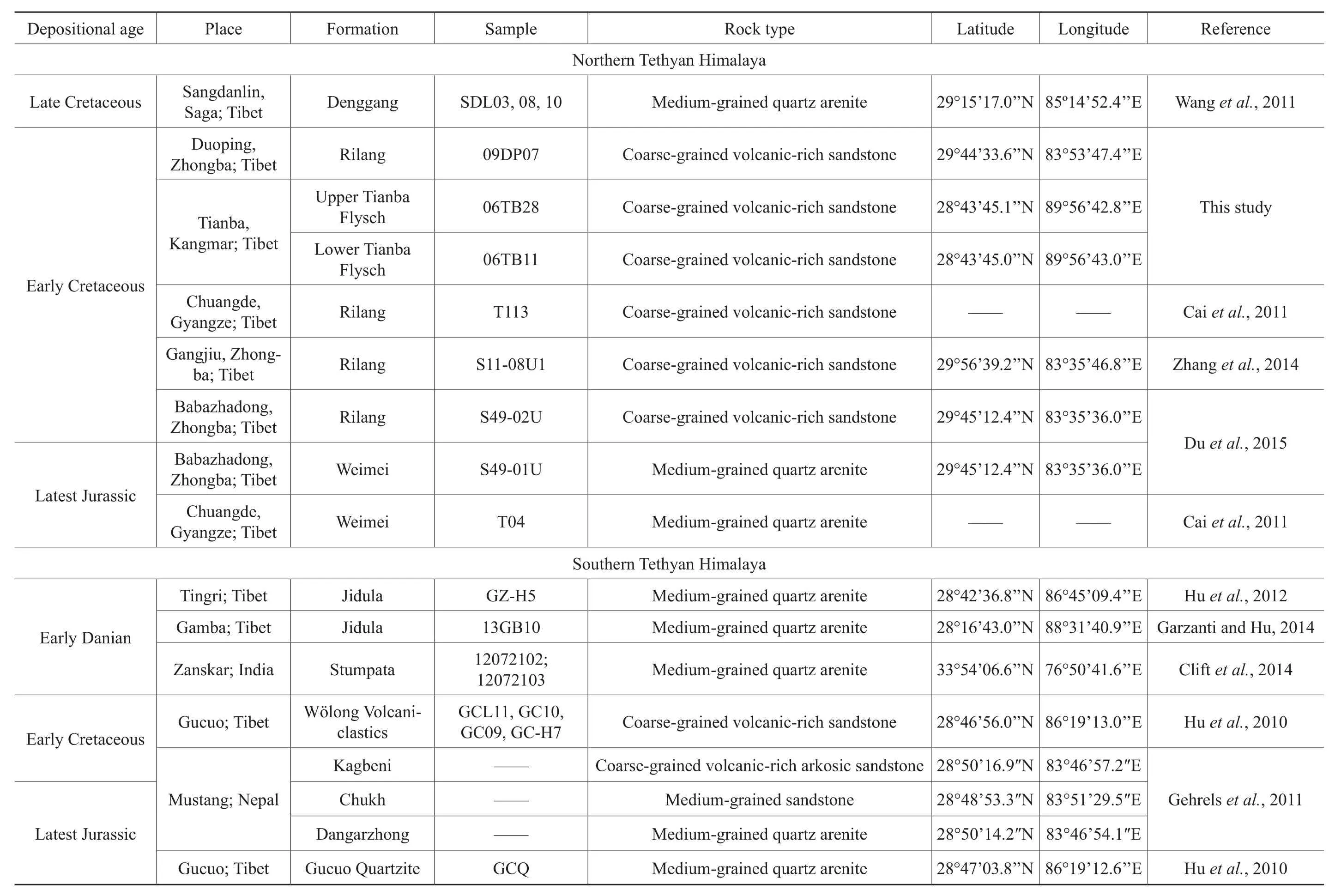
Table 1 List of sandstone samples analyzed for detrital-zircon geochronology. Samples from the northern Tethyan Himalaya, southern Tethyan Himalaya and Lesser Himalaya range in ages from Devonian to Paleocene

Table 1 , continued
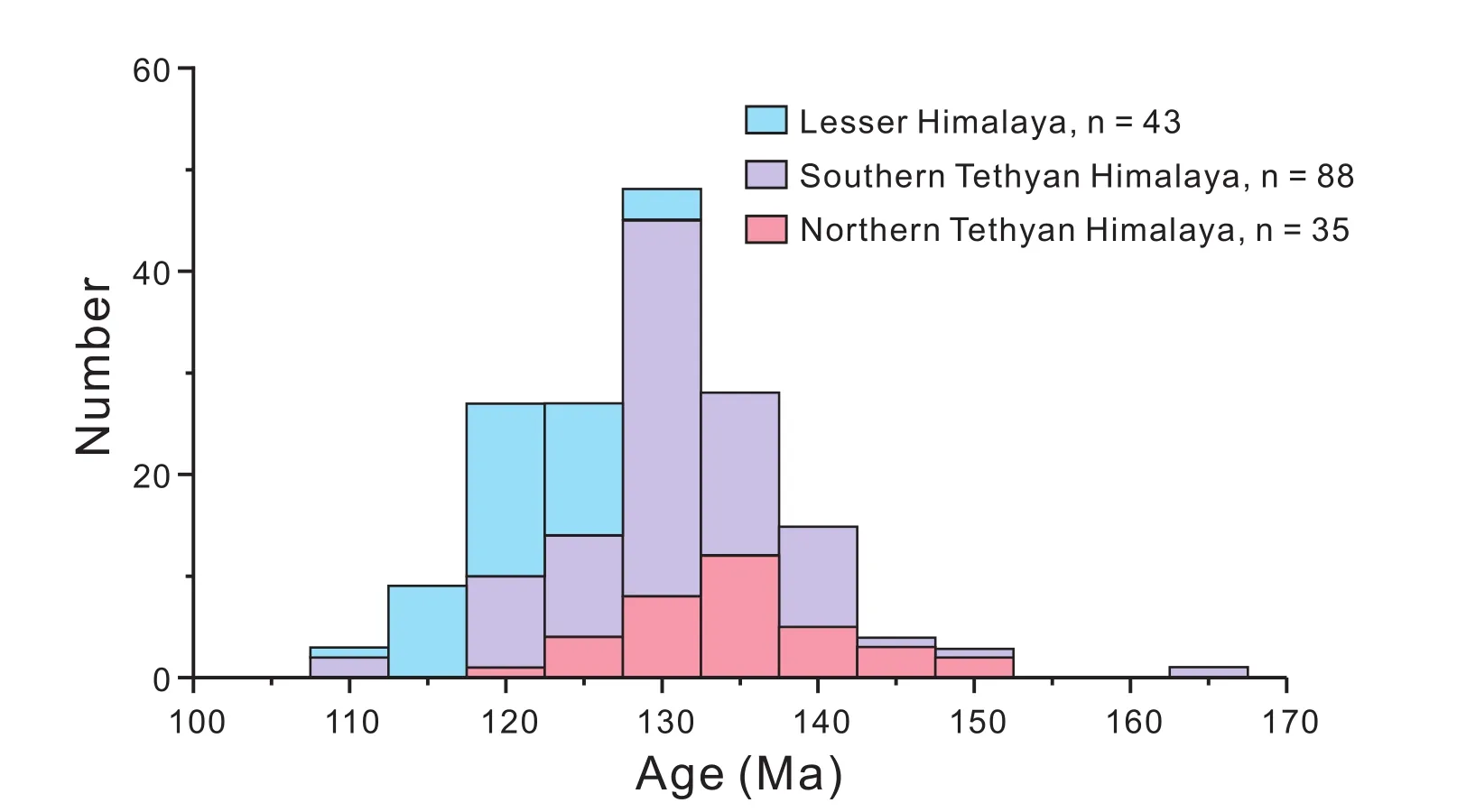
Figure 3 Comparison of Early Cretaceous detrital zircons from the northern Himalaya, southern Tethyan Himalaya, and Lesser Himalaya. Zircon ages cluster between 127-110 Ma in the Lesser Himalaya, and are thus younger than those found in both southern and northern Tethyan Himalaya (148-116 Ma). Data sources provided in Table 1.
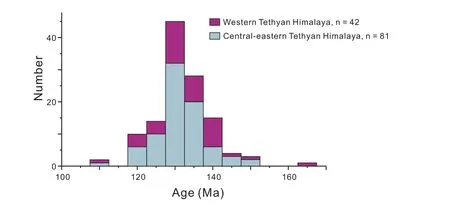
Figure 4 Comparison of Early Cretaceous detrital zircons from the central?eastern and western Tethyan Himalayas. Data sources provided in Table 1.
6 Early Cretaceous palaeogeography:Provenance and drainage system
Palaeocurrent data show that Lower Cretaceous vol?caniclastic sediments were all fed from the south or south?east (Sakai, 1989; Dürr and Gibling, 1994; Giblinget al.,1994; Garzanti, 1999; Huet al., 2010). Sandstone petrog?raphy and detrital?zircon geochronology indicate that de?tritus from penecontemporaneous volcanic rocks mixed with sediment recycled from older siliciclastic units and/or basement rocks. The source area was thus represent?ed by northern India, including the proximal part of the continental margin and the Pan?African Orogen (Garzantiet al., 1986; Cawoodet al., 2007; Myrowet al., 2010),rejuvenated and dynamically uplifted at the onset of the magmatic event.
Huet al.(2010) suggested that the Early Cretaceous volcanic activity in the northern Indian margin took place along deep?seated leaky extensional faults generated during unzipping of India from Australia/Antarctica, ac?companied by minor counter?clockwise rotation (Ali and Aitchison, 2008). This final stage in the break-up of Gond?wana caused a change in the direction of the regional stress field along the northeastern Indian margin (Powellet al.,1988). Deep?seated fractures cutting across the continental crust allowed decompression melting and the rise of man?tle?derived basaltic magma, which mixed in later stages with partial melts of continental crust, as suggested by the Hf isotopic signatures of Early Cretaceous detrital zircons[εHf(t)= -0.2 - -7.2; n = 31] (Huet al., 2010, 2012). The Tansen Basin, situated in an extensional continental setting and fed from a southern rift?shoulder consisting of Lesser Himalayan rocks, formed above a deep?seated fault along which alkalic basalts, trachytes and trachyandesites were erupted. Sandstone petrography and detrital geochronol?ogy suggest that there were possibly distinct volcanic cent?ers supplying volcaniclastic detritus to the Indian margin.The existence of a significant eastern center as old as the Tithonian, documented poorly so far in outcrops (e.g., Zhuet al., 2008), is indicated by the Tithonian of basal W?long volcaniclastic sandstones and by the latest Jurassic age of a few detrital zircons. Other centers are more clearly iden?tified as the Comei igneous province of the southeastern Tibet, active around 132 Ma (Zhuet al., 2009), and the Rajmahal?Silhet igneous province of northeastern India,active around 117 Ma (Ghatak and Basu, 2011). Lower Cretaceous volcanic rocks are unknown west of Nepal,but abundant volcaniclastic detritus in the Pingdon La Formation of the Zanskar?Spiti region implies either the existence of a yet undocumented Aptian volcanic center in the west, or the development of a large westward drainage system conveying detritus along the Indian margin from volcanic centers in the east.
This latter hypothesis suggests in turn that massive eruptions of continental-flood basalts during subsequent stages of the Early Cretaceous in southeastern Tibet and northeastern India (Comei and Rajmahal large igneous provinces) were probably associated with domal uplift,with consequent development of a radial centrifugal drain?age system and sediment dispersal, as observed for most large igneous provinces around the world (Cox, 1989;Moore and Blenkinsop, 2002). This scenario may also ex?plain why U-Pb ages of detrital zircons tend to cluster in younger groups from north to south across the central?eastern Himalaya (Figure 3). A greater contribution from the older Comei igneous province is indicated for Tethys Himalayan units. Instead, younger zircon?ages clustering between 127-110 Ma in Lesser Himalayan units reveal supply mostly from the Rajmahal region, via a distinct southern river possibly flowing along a failed arm of the associated rift system (Sakai, 1989, his Figure 5A).
Volcanism ceased everywhere by ~110 Ma. Clastic sedimentation was followed by synchronous drowning of terrigenous shelves all along the Tethys Himalaya in the late AlbianSubticinensis(Breggiensis) Zone, during a period of major starvation that lasted throughout the Cenomanian in the Zanskar Range (107-94 Ma; Garzantiet al., 1989). Tethys Himalayan volcaniclastic to quartzose sediments were slowly buried by foraminiferal oozes de?posited in deepening pelagic environments since the close
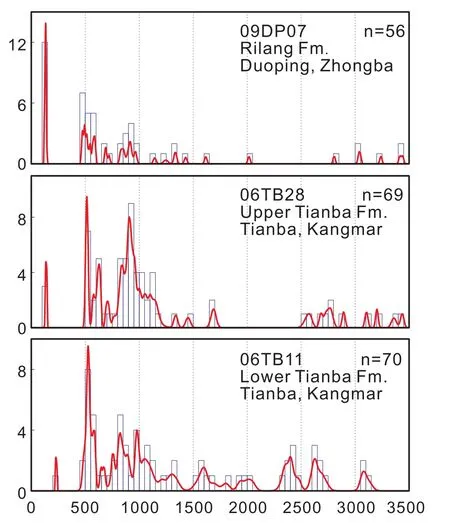
Figure 5 U-Pb age distributions of detrital zircons in the three samples from the Lower Cretaceous units of the northern Tethyan Himalaya. Data sources provided in Table 1. Fm. = Formation.
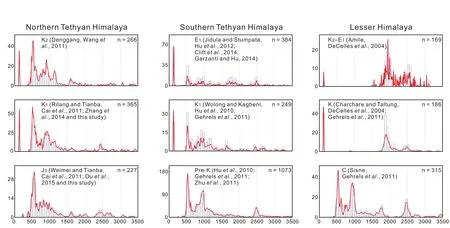
Figure 6 Comparison of detrital zircons from the northern Tethyan Himalaya (top), southern Tethyan Himalaya (middle), and Lesser Himalaya (bottom). Pre?Cretaceous units are repre?sented in the three lower panels, Lower Cretaceous units in central panels, and Upper Cretaceous-Paleocene units in upper panels. Data sources provided in Table 1.
of the Albian (TicinensistoAppenninicazones; 103-101 Ma; Premoli Silvaet al., 1991; Huet al., 2008). These units include the Chikkim and Fatu La Formations of the Spiti-Zanskar Synclinorium (Garzanti, 1993a; Bertle and Suttner, 2005), the Bolinxiala Formation of southwestern Tibet (Zanda area; Liet al., 2009), the Muding Formation of Nepal (Giblinget al., 1994; Garzanti, 1999), and the Gambacunkou Formation of southern Tibet (Willemset al., 1996). Drowning of the Indian passive continental margin is ascribed to waning sediment supply, cooling of the crust and thermal subsidence at the end of the magmatic event (Garzanti, 1993a, 1993b).
7 Conclusions
This study provides new U-Pb ages of detrital zircons obtained from three Lower Cretaceous sandstones of the northern Tethyan Himalaya, integrated with a comprehensive compilation of previously published data from other Cretaceous to Paleocene Himalayan sandstone units.Early Cretaceous ages of detrital zircons cluster mainly between 142-123 Ma in the northern Tethyan Himalaya(with two grains at 148-147 Ma, and one at 117 Ma), and between 140-116 Ma in the southern Tethyan Himalaya(with one grain at 161 Ma, one at 147 Ma, and two at 109 Ma). These data indicate that the Early Cretaceous magmatic event which affected the passive continental margin of northern India began close to the Jurassic/Cretaceous boundary around 148-147 Ma, and ended in the early Albian by ~110 Ma. This time window coincides well with volcaniclastic sedimentation in southern Tibet, which is confined between the Tithonian and the Aptian (Jadoulet al., 1998).
Stratigraphic data document the progressive westward migration of volcaniclastic sedimentation, which started as early as the latest Jurassic in southern Tibet but did not begin until the late Aptian/early Albian in the Zanskar-Spiti region of the western Himalaya. An equivalent heterochroneity in magmatic activity, which would have suggested the progressive westward propagation of deep-seated leaky extensional faults generated during unzipping of India from Australia/Antarctica (as proposed by Huet al.,2010), is not supported by the age distributions of detrital zircons, which do not show remarkable differences from east to west. Alternatively, we suggest here that a major drainage system progressively prograding westwards may have conveyed volcanic detritus along the Indian margin from the same volcanic centers in the east. This provenance interpretation is supported by the fact that Early Cretaceous volcanic rocks were only found in the eastern part of the northern Indian margin so far, and are unknown in western Nepal. Development of radial drainage and sediment dispersal away from the domal uplift caused by magmatic upwelling is observed for most large igneous provinces around the world (Cox, 1989) and might have developed also for the Early Cretaceous Comei-Rajmahal-Sylhet igneous provinces of southeastern Tibet and northeastern India.
Acknowledgements
We thank Lei Chen and Jian-Gang Wang for their assistance both in the field and in the lab. Discussion with Rufus Bertle on Cretaceous stratigraphy of Spiti was highly appreciated. We are grateful to Zeng-Zhao Feng, Lin-Zhi Gao, and Harutaka Sakai, for their constructive comments.This study was financially supported by the Strategic Priority Research Program (B) of the Chinese Academy of Sciences (XDB03010100), the Chinese MOST 973 Project (2012CB822001) and the NSFC Project (41172092).This is a contribution to the IGCP609.
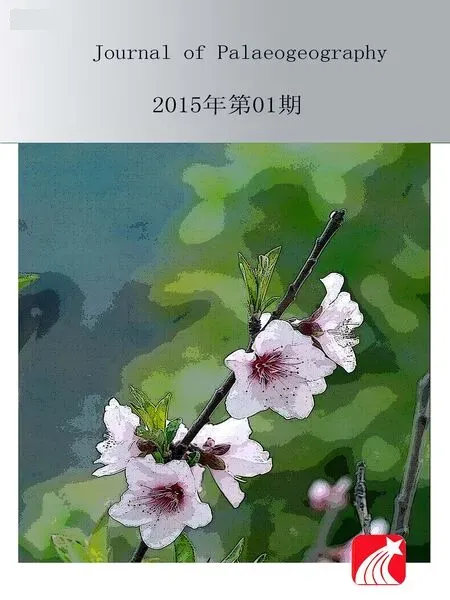 Journal of Palaeogeography2015年1期
Journal of Palaeogeography2015年1期
- Journal of Palaeogeography的其它文章
- 3D palaeogeographic reconstructions of the Phanerozoic versus sea-level and Sr-ratio variations
- Modern Black Sea oceanography applied to the end-Permian extinction event
- Nonmarine time-stratigraphy in a rift setting: An example from the Mid-Permian lower Quanzijie low-order cycle, Bogda Mountains, NW China
- A revised Mississippian lithostratigraphy of County Galway (western Ireland) with an analysis of carbonate lithofacies, biostratigraphy, depositional environments and palaeogeographic reconstructions utilising new borehole data
- General regulations about submitting manuscripts to Journal of Palaeogeography
- 2nd International Palaeogeography Conference October 10?13, 2015
